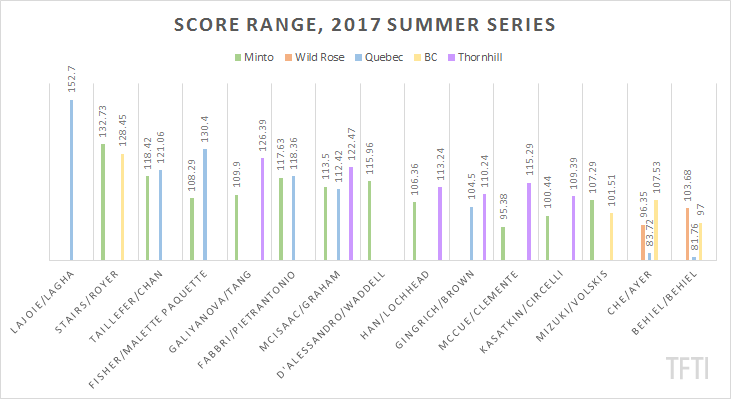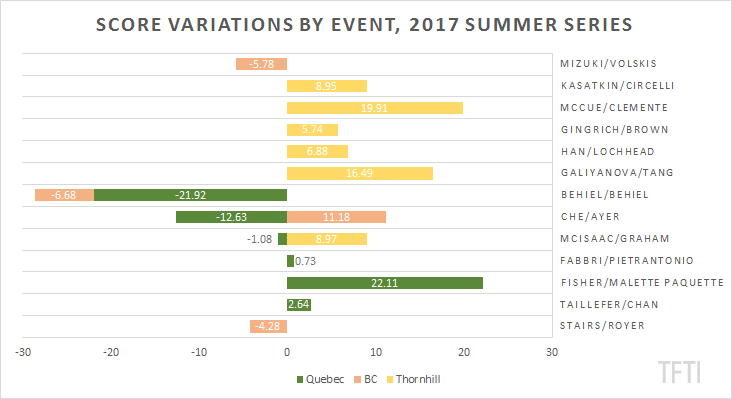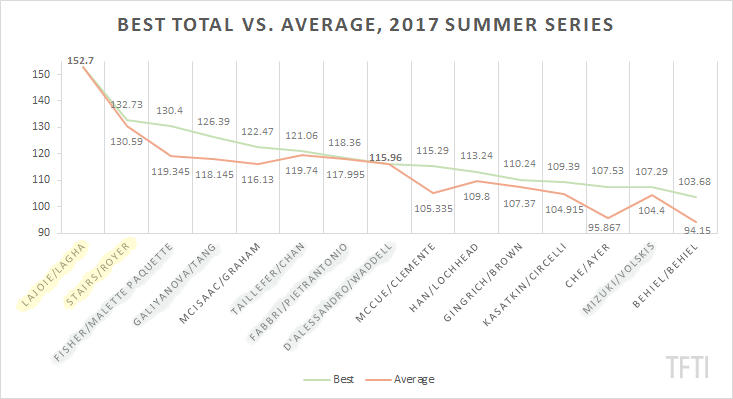In addition to our Snapshot Stats on Tumblr, this Olympic season we’ll also be taking a numbers-oriented look right here at the topic of international assignments: who gets them, who doesn’t, and how often does reality reflect promise? Kicking things off, a first look at Canada’s NextGen program.
Heading into the 2017-18 skating season, Skate Canada revealed its NextGen program — a junior supplement to its High Performance program, “the purpose [of which] is to ensure athletes and coaches advance at their maximum potential through development and training opportunities,” notes the site, “in order to be the best in the World and Olympic Games.” Reasonably, the seven-team roster includes 2017 junior national medalists Marjorie Lajoie and Zachary Lagha and Ashlynne Stairs and Lee Royer1. Similarly, novice champions Natalie D’Alessandro and Bruce Waddell, though just meeting international age minimums — D’Alessandro is 13 — have also been recognized.
But the field beyond that is premised not on podium positioning, but, likely, the ability last year to fulfill specific criteria laid out by the program. Besides Lajoie/Lagha and Stairs/Royer, every other still-extent team who competed on last year’s Junior Grand Prix — assignments which were themselves often predicated on performance at 2016 Nationals or in the 2016 summer club events — are included here:
Alicia Fabbri and Claudio Pietrantonio (5th, 2017 Canadian Nationals | 4th, JGP Cup of Mordovia; 6th, JGP Pokal der Blauen Schwerter)
Irina Galiyanova and Tommy Tang (6th, 2017 Canadian Nationals | 11th, JGP Tallinn Cup)
Olivia Han and Grayson Lochhead (8th, 2017 Canadian Nationals | 8th, JGP Yokohama)
Fourth-place national finishers Valerie Taillefer and Jason Chan, still competing, did not receive a 2016 JGP assignment, nor did seventh-place finishers Sabrina Bedard and George Waddell, who split following the 2016-17 season. JGP competitors Hannah Whitley and Elliott Graham split prior to Nationals.
For 2016-17’s novice teams, those moved up to the junior ranks now but who, naturally, did not compete on last year’s JGP circuit, criteria for their inclusion here was presumably based on accomplishment of the technical goalposts outlined in the link above. This means that second- through fourth-place national finishers Jade McCue and Gabriel Clemente, Jessica-Lee Behiel and Jackson Behiel, and Katerina Kasatkin and Corey Circelli are not included in the NextGen field, but fifth-place finishers Nina Mizuki and Veniamins Volskis are, given these parameters:
Teams looking ahead to two or fewer years of junior eligibility must have executed (primarily at Canadian Nationals and/or Skate Canada Challenge) a free dance with step sequences of at least Level 2 and Level 3, Level 4 twizzles, and a GOE per-element average of at least 0.75. Teams with three or more remaining years of junior eligibility must have executed two step sequences of at least Level 2, Level 3 twizzles, and a GOE average of at least 0.5.
D’Alessandro/Waddell:
CHALLENGE: L2 step sequences; L3 twizzles; GOE average of 0.74.
NATIONALS: L2 and 3 step sequences; L3 twizzles; GOE average of 0.82.
McCue/Clemente:
CHALLENGE: L1 step sequences; L1 twizzles; GOE average of 0.149.
NATIONALS: L2 step sequences; L2 twizzles; GOE average of 0.539.
Behiel/Behiel:
CHALLENGE: L1 and 3 step sequences; L4 twizzles; GOE average of 0.18.
NATIONALS: L2 and 3 step sequences; L4 twizzles; GOE average of 0.379.
Kastkin/Circelli:
CHALLENGE: L1 and 3 step sequences; L4 twizzles; GOE average of 0.657.
NATIONALS: L1 and 2 step sequences; L4 twizzles; GOE average of 0.686.
Mizuki/Volskis:
CHALLENGE: L3 step sequences; L4 twizzles; GOE average of 0.75.
NATIONALS: L1 and 2 step sequences; L4 twizzles; GOE average of 0.57.
These decisions were finalized in early summer, well before the publication of the first assignments for the 2017-18 Junior Grand Prix and certainly before Canada’s National Summer Series (NSS) competition circuit opened with July’s Minto Summer Skate and concluded last weekend with Skate Ontario Summer Skate (Thornhill). But we’ve now reached late August; JGP Brisbane, the season’s first major international, is underway, and Canada’s ice dance assignments, however preliminary, for the next four of six more JGP events have been published.
Over the course of the NSS, 23 junior dance teams competed at up to three of five events; for the sake of relative simplicity, we’ve looked only at the top 15 finishers overall, a number that includes all teams presently assigned to a JGP event. With the exception of Lajoie/Lagha and D’Alessandro/Waddell, who were assigned the earliest JGP, each team here competed at least twice, with total scores sometimes swinging quite significantly from one event to the next:

While some teams saw only a small deviation in scores, it’s still worth taking a closer look at event to event trends:

For those teams who competed at three events, third scores were compared against first rather than second as a baseline, given the Quebec score decrease for each.
And now let’s consider the best scores and overall averages delivered by these couples as, significantly, JGP assignments began to expand beyond NextGen team membership with the third event. Valerie Taillefer and Jason Chan have picked up a spot for that competition, while picks for the fifth event include new team Ellie Fisher and Simon-Pierre Malette Paquette. Highlighted below in lavender are those teams with a single assignment, while those in yellow have the maximum two:

With selections for two events remaining to be revealed, Canada should have up to four more spots to fill, though good performance from a lavender-hued team at one of the initial events could grant them a second spot. And shortly before publication of this article, and certainly post-chart creation, new couple Olivia McIsaac and Elliott Graham — he the only non-NextGen ice dancer with prior JGP experience2— announced their addition to the sixth event. It seems, then, that the international assignment mechanism, whatever the benefits of the NextGen program’s additional team resources, has this year followed a fairly logical process in terms of reward for summer achievement.
But let’s also consider the scoring benchmark suggested in the NextGen criteria document for actual inclusion in that program. While teams with three or more seasons of junior eligibility remaining (i.e. those in which the male will not turn 21 or the female 19 until after July 1, 2019) need only attain a minimum total score of 105, those with one fewer year of eligibility are expected to achieve a full 35 points better — something not a single team other than Lajoie/Lagha has accomplished in the current field. At this year’s Canadian Nationals, silver medalists Stairs/Royer picked up only 139.63 points, their best score at any major event in the 2016-17 season. Internationally, Lajoie/Lagha only surpassed 140 on two occasions, with a 148.26 at the World Junior Championships and 141.20 at Bavarian Open. It’s not unreasonable to consider that a slightly lower goalpost, perhaps 125-130, would still suggest a high bar for entry without completely undermining opportunity for older juniors, or new partnerships formed later in the junior career — and closer to the senior ranks, a time when, given Canada’s very small field, it might be wise to support those with later-blooming promise.
